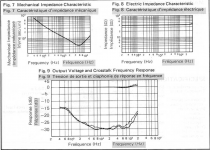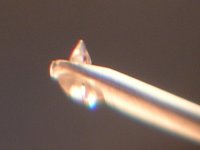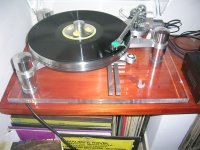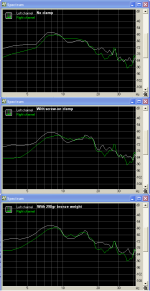Sorry but I find the 'Err.rh' irksome. Could I request you try and limit its use when quoting me.Err.rh!
I did some googling and found no mention of neutrality in the specs. Yes it was spec'd for high mass arms, and there is likely to be an inferred DJ proof requirement in there, but nothing about neutrality being a key requirement. Do you have any references? FWIW Denon currently say 'The DL-103 gives a pleasing sound'. There is an article where Jean Hiraga says some interesting things, but my schoolboy french is not good enough to translate on the fly.Denon 103 was designed for the NHK (the Japanese BBC). Neutrality was high on the list of priorities. Also low record wear.
My personal view is that it is was build so they didn't have to import SPUs and had a home grown solution and its same era tech. Not for me. A DL-102 as the cheapest true mono with vertical compliance I could be tempted to try one day.
I'd rather use silicone damping troughs front and back. I've seen enough measurements from members of all sorts of arm tech to see that ALL combos have a very significant bump around the resonant frequency. I don't see a good reason that low mass makes a difference as long as the mechanical system is matched for it.Don't forget to include substantial subsonic filtering in your preamp to get the greatest benefit from a low arm mass solution. The reason is in Holman. To gild the lily, you might want to match the Q of your 20Hz subsonic filter to the anticipated rise at frequencies around 20Hz.
but nothing about neutrality being a key requirement. Do you have any references?
Now on a new TT (measurements to follow soon) 🙂
George
Attachments
Oracle and audiomods. Nice combo. Will be interesting in your feedback on the audiomods arm as seriously considering adding one to the toy wish list.
EDIT: Should note I have the right arm for that table on my Roksan (Oracle 345). Sorry not parting with it...
EDIT: Should note I have the right arm for that table on my Roksan (Oracle 345). Sorry not parting with it...
Last edited:
Actually there is.I'd rather use silicone damping troughs front and back. I've seen enough measurements from members of all sorts of arm tech to see that ALL combos have a very significant bump around the resonant frequency. I don't see a good reason that low mass makes a difference as long as the mechanical system is matched for it.
The Q of a (2nd order) system is the ratio of its Reactive parts, Stiffness & Mass, vs the Resistive parts.
You can achieve a specific resonant frequency by either using high mass & high stiffness OR a low mass and low stiffness.
The low mass, low stiffness system will have lower Q and will be easier to damp further too.
__________________________
The evils of silicone trough damping are highlighted in Holman.
That may be ... but its a bit strong condemning 103 for 'lack of neutrality' ... especially as you said you've never heard one 😱My personal view is that it is was build so they didn't have to import SPUs and had a home grown solution and its same era tech. Not for me.
It's popular with mastering labs as an unhyped cartridge. What do you recommend in its price range for neutral?
But as with speakers, you should always buy the one you like on YOUR music ... and damn what all the reviewers, experts & inperts say 🙂
Last edited:
Holman only mentions issues with trough damping wrt warps. I don't play warped records therefore its not an issue for ME.
Certainly news to me on mastering studios using 103s. They always used to use Shure VSTs generally on SME3012 arms to check laquers based on interviews I read, but I have never been to a mastering studio. I have never heard one, but I have never read a review that says it's neutral. either its chinese whispers and everyone repeats what they have heard, or its coloured somehow. I have no recommendations for MC in that range, but my 'cheap' cartridge I have lined up is an AT150MLx which is about as far from a broadcast cartridge as you can get. Purchase based entirely on a combination of prejudice and wanting to experiment with some ideas. All just for Lolz as the SME/Benz combo is a sweet spot for me.
Certainly news to me on mastering studios using 103s. They always used to use Shure VSTs generally on SME3012 arms to check laquers based on interviews I read, but I have never been to a mastering studio. I have never heard one, but I have never read a review that says it's neutral. either its chinese whispers and everyone repeats what they have heard, or its coloured somehow. I have no recommendations for MC in that range, but my 'cheap' cartridge I have lined up is an AT150MLx which is about as far from a broadcast cartridge as you can get. Purchase based entirely on a combination of prejudice and wanting to experiment with some ideas. All just for Lolz as the SME/Benz combo is a sweet spot for me.
The issue that I see with the DL-103 is that it transmits vibrations to the tonearm.
The cartridge motor is neutral.
What can be easily coloured is the output from the cart on an excited arm.
Damping and isolation.
Where to apply these and how much is for the joy of the experimentation (the bread and butter of a diyer 😀 )
George
The cartridge motor is neutral.
What can be easily coloured is the output from the cart on an excited arm.
Damping and isolation.
Where to apply these and how much is for the joy of the experimentation (the bread and butter of a diyer 😀 )
George
That is a very plausible reason. I guess few have the sort of broadcast arms man enough for them these days. Perhaps I should feel sad I jumped straight from the AT-95 to the Benz and completely skipped this.
I guess few have the sort of broadcast arms man enough for them these days.
That’s very true.
Despite this, it still sells well today.
When I bought the DL-103 for 120Euro in 2009, Shure M97xE was selling at 90 Euro, same as 2006 that I had bought mine.
Today, M97 is still at 90 Euro, DL-103 though has stepped up at 240 Euro, a price level where there is a good competition among MCs.
George
well I had to go off and do some research. I've generally not paid much interest to the broadcast arm/cartridge market as, well I'm not a DJ. But it seems there are quite a few broadcast carts still popular including
EMT TSD-15
Shure SC35C
Ortofon SPU
DENON DL-103
All stupidly low compliance and needing a girder of an arm (exaggeration). Well I now see why Lenco L75 owners like DL-103s! Makes the genesis of the ortofon DJ carts all the more amusing as they started life as the lightest of light and now come with lead saddles.
(aside: Since Garrard idlers got silly costly Lencos are the in thing for DIY, to the point where people are stripping them and selling the parts. On ebay at the moment, you cannot buy a complete L75 arm, just the bits. Now 2 years ago you couldn't give them away, now its over £100 for the bits before you start refurbing. Good for the hobby as long as it doesn't go all tulip on us)
EMT TSD-15
Shure SC35C
Ortofon SPU
DENON DL-103
All stupidly low compliance and needing a girder of an arm (exaggeration). Well I now see why Lenco L75 owners like DL-103s! Makes the genesis of the ortofon DJ carts all the more amusing as they started life as the lightest of light and now come with lead saddles.
(aside: Since Garrard idlers got silly costly Lencos are the in thing for DIY, to the point where people are stripping them and selling the parts. On ebay at the moment, you cannot buy a complete L75 arm, just the bits. Now 2 years ago you couldn't give them away, now its over £100 for the bits before you start refurbing. Good for the hobby as long as it doesn't go all tulip on us)
Are you sure (SHURE?) about this George?The issue that I see with the DL-103 is that it transmits vibrations to the tonearm.
It's some 30 yrs since I used one but Denon 103 has quite low tip mass which is the main factor in exciting both the record and the arm.
As I said, it is the trackability which correlates with vibrating vinyl and arms.
Of course, it is possible that a cartridge has such low compliance that this affects trackability at LF and this would then transmit stuff to the record & arm .. but DL-103 has actually quite good balance of trackability features.
It does need a medium mass arm though which might have led to this myth. My senile memory may be faulty but I think I used it with an SME Series 3 (gold titanium tube) with added mass ... also a Linn Ittok.
______________
It's quite easy to have a good handle on which cartridges excite the record and which arm. Just listen to the acoustic noise while playing a heavily modulated groove. Your amp is switched off.
This is in essence what the 1980s (?) B&K papers on the subject are measuring.
______________
BTW, I take with a LARGE pinch of salt anyone who reports DL-103 has LESS bass in a low mass arm. The low mass arm & low compliance leads to a large bump in the audible LF range.
As a DBLT guru, I would classify anyone reporting LESS bass as a wannabe Golden Pinnae .. ie deaf.
______________
LD, another tidbit from senile Jurassic memories ..
If a 'resonance' is due to cantilever modes, one of the surest signs is that the crosstalk worsens dramatically. This also happens with the (mythical?) compliance/vinyl resonance and the compliance/tip mass resonance but not so dramatically.
The clearest example of this is the Decca cartridges with their VERY pronounced cantilever resonances. Loads caveats damping of Decca cartridges only intelligible to those versed in da arcane arts. IIRC, you see this in V15 - I and also in the SHURE papers which document V15 - II Improved etc.
Last edited:
BTW, an L75 arm is VERY prone to excitation by 'low compliance' cartridges. It is HIGH MASS though. 😀On ebay at the moment, you cannot buy a complete L75 arm, just the bits. Now 2 years ago you couldn't give them away, now its over £100 for the bits before you start refurbing.
It's certainly NOT on my list of 'wants'. But just a realisation that I really should have squirreled away the things I needed when they were cheap.
that should be ".. (mythical?) vinyl/tip mass resonance and the compliance/tip mass resonance .."This also happens with the (mythical?) compliance/vinyl resonance and the compliance/tip mass resonance but not so dramatically.
Are you sure (SHURE?) about this George?
Ricardo with all the MM/MI cartridges I’ve used, I’ve learned to be a proponent of tight coupling of the cartridge to the arm, of the arm to the board, of the board to a bigger mass below. See this thread where I object to any form of decoupling or damping up front
http://www.diyaudio.com/forums/analogue-source/100408-results-m97xe-mod.html
With the DL-103 on an SME 3009 Series II Impr., I had to steer 180degrees away from this approach.
I went through tens of recordings using test tracks and comparing their FFTs for to see the parasitic vibrations, apply modifications, retest and proceed further (running the risk of overcompensating if not doing listening tests in parallel to the test tones).
Finally, at less than it’s max tracking weight, it could track the +18dB 300Hz of the HFN test record (Side 1 Band 9, the ‘torture track’) at the onset of waveform distortion both at the beginning and at the end of the track , a difficult achievement.
And yes, listening to the cartridge ‘singing’ with a naked ear is a coarse qualitative test of the acoustic excitation the cartridge produces. But it is only an observation.
Careful testing and analysis has to follow.
George
Attachments
That has certainly been my experience.Ricardo with all the MM/MI cartridges I’ve used, I’ve learned to be a proponent of tight coupling of the cartridge to the arm, of the arm to the board, of the board to a bigger mass below. See this thread where I object to any form of decoupling or damping up front
http://www.diyaudio.com/forums/analogue-source/100408-results-m97xe-mod.html
That's an excellent thread. I thought I was being adventurous in my 1980s cartridge design/mods but yus guys are in another league 😱
Can you explain a bit more.With the DL-103 on an SME 3009 Series II Impr., I had to steer 180degrees away from this approach.
3009 Series II Imp is certainly not the right arm for DL103.
Just an arcane tidbit. To prevent vibrations getting into the 'arm', the best place for mass is at the 'headshell'. Whether you like it or not, the distribution of masses & stiffness form a LP filter and headshell mass is the first stage in the LC...LC filter. .. as George says, you don't want any wonky stiffness at the headshell.
Series III with added mass works quite well with DL103 but I wouldn't use Series II Imp with or without added mass.
I started listening to cartridge 'singing' after playing around with the B&K Test Record which was issued after Ladagard's (?) B&K paper.And yes, listening to the cartridge ‘singing’ with a naked ear is a coarse qualitative test of the acoustic excitation the cartridge produces. But it is only an observation.
Careful testing and analysis has to follow.
_____________
Another arcane tidbit .. Werner in #33/34 of
http://www.diyaudio.com/forums/analogue-source/100408-results-m97xe-mod-4.html
shows M97xE with different load C.
There isn't a load C which gives 'flat' response and still goes up to 20kHz. IIRC, this was first investigated for V15 Type I and the 'cure' was to change the RIAA HF constant from 75us to 50us. John Crabbe, then editor of HFN, was the main instigator.
You can see that this TC change, with load C 150p would give a very nicely flat response ... assuming Werner's test records were flat response. It's very likely a pink noise track is dropping at 20kHz 🙂
How was the ultralight series 3 a better match than the 2 improved? Serious question as on first inspection it would seem to be worse.
Aside : For the well heeled anacrophile SME Tonearms Upgrades
Aside : For the well heeled anacrophile SME Tonearms Upgrades
Because the Titanium armtube with connector near the pivot was actually STIFFER than the fat alloy Series 2 Improved with fixed headshell.How was the ultralight series 3 a better match than the 2 improved?
There are a few cartridge/arm combinations that have proven serendipity.
SHURE V15 Type III with SME Series II improved is one of them. On a Thorens TD126 or course (but replace the vestigial Thorens mat) Da audiophools will sneer but listening to such a well set up & preserved system immediately tells you why it was so popular.
I imagine a pipe smoking, somewhat elderly, gentleman, like Bill, playing only Elgar through his QUAD system with da new fangled ESL63s 🙂
Ah fairy nuff. The series III is an arm I would own if one came up at the right price. Unlikely to ever happy tho and the damping trough is worth as much as the arm and gets stripped off and sold seperately.
Elgar yes, was listening to that last night as had found a mono Decca at my fave record shop for £2. No pipe, no QUADs and def no ESLs. As for Elderly I reckon you have at least a decade on me!
Elgar yes, was listening to that last night as had found a mono Decca at my fave record shop for £2. No pipe, no QUADs and def no ESLs. As for Elderly I reckon you have at least a decade on me!
Wet Cleaning machines.
LD, does your theory explain why wet cleaning eg the Keith Monks / Audio & Design machine and IIRC, the Discwasher work?
These use a water/alcohol mixture and they certainly reduce clicks & pops when dry played after their use.
Why don't they 'damage' the groove permanently like wet playing?
LD, does your theory explain why wet cleaning eg the Keith Monks / Audio & Design machine and IIRC, the Discwasher work?
These use a water/alcohol mixture and they certainly reduce clicks & pops when dry played after their use.
Why don't they 'damage' the groove permanently like wet playing?
- Home
- Source & Line
- Analogue Source
- Reducing Record Surface Noise - I want to know all Approaches





